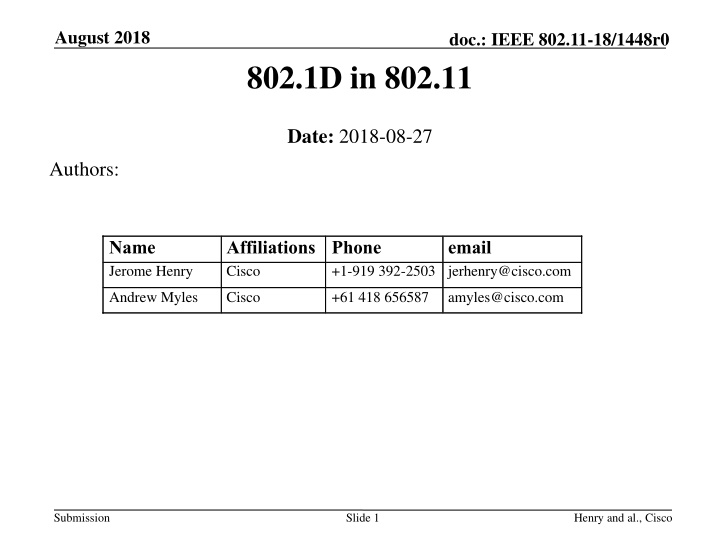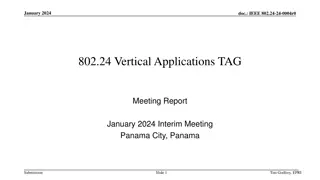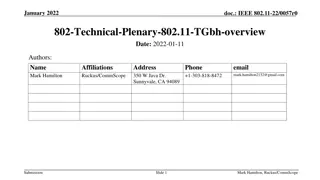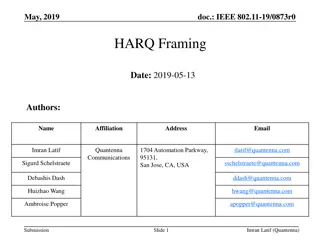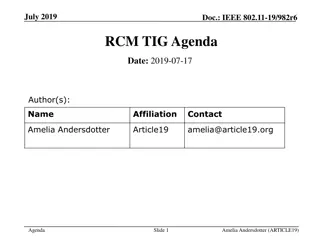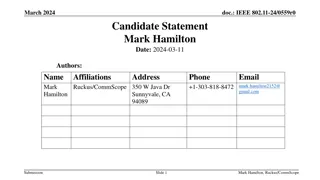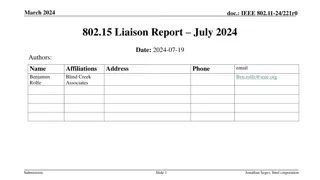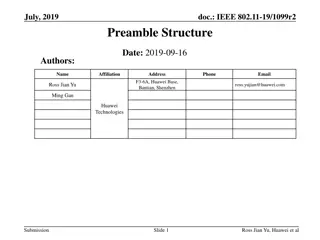Evolution of Standards: IEEE 802.11 and 802.1D Relationship
Explore the relationship between IEEE 802.11 and 802.1D standards, discussing the necessity of referencing old standards, the state of 802.1D, and the potential for removing outdated references in 802.11. The submission proposes a migration model while emphasizing the importance of staying current with industry practices.
Download Presentation

Please find below an Image/Link to download the presentation.
The content on the website is provided AS IS for your information and personal use only. It may not be sold, licensed, or shared on other websites without obtaining consent from the author.If you encounter any issues during the download, it is possible that the publisher has removed the file from their server.
You are allowed to download the files provided on this website for personal or commercial use, subject to the condition that they are used lawfully. All files are the property of their respective owners.
The content on the website is provided AS IS for your information and personal use only. It may not be sold, licensed, or shared on other websites without obtaining consent from the author.
E N D
Presentation Transcript
August 2018 doc.: IEEE 802.11-18/1448r0 802.1D in 802.11 Date: 2018-08-27 Authors: Name Jerome Henry Affiliations Phone Cisco email +1-919 392-2503 jerhenry@cisco.com Andrew Myles Cisco +61 418 656587 amyles@cisco.com Submission Slide 1 Henry and al., Cisco
August 2018 doc.: IEEE 802.11-18/1448r0 Abstract During discussion on resolution of LB232 CID 1014, observations were made that 802.11 sometimes references 802.1D, which diverges from 802.1Q Participants debated whether 802.1D was necessary for 802.11 This submission explores the relationship between 802.1D and 802.11, and proposes a migration model. Submission Slide 2 Henry and al., Cisco
August 2018 doc.: IEEE 802.11-18/1448r0 State of 802.1D The latest version of 802.1D is 802.1D-2004 (14 years ago) It hasn t been updated since 2004*, not because it is in a state of ethereal perfection , but rather because its features have been incorporated in other standards 802.1Q (Bridges and Bridged Networks) 802.1AC (MAC Service Definition) * Two amendments were added (but no integration into 802.1D standard), 802.17a (802.17 bridging support, 2004) and 802.16k (802.16 bridging support, 2007) Submission Slide 3 Henry and al., Cisco
August 2018 doc.: IEEE 802.11-18/1448r0 Should 802.11 reference an old standard? Each standard evolves, and so do the associated practices Referencing a standard is only meaningful if the standard is current, and reflects industry practices A standard that is not updated shows that it is getting disconnected from the industry The risk with referring to an old standard is that our standard may get a growing disconnect with the industry practices Using 802.1D as a reference already causes disconnects with 802.11ak Submission Slide 4 Henry and al., Cisco
August 2018 doc.: IEEE 802.11-18/1448r0 Can we remove old references? 802.11 references a standard that is old and not updated anymore Can 802.11 follow newer industry practices and reference the new standard? Update 802.11 text and reference Is the content of that old standard integrated in a new standard? yes yes no no Is the content of that old standard current for 802.11? Integrate required old standard content into 802.11 yes no Remove references in 802.11 Submission Slide 5 Henry and al., Cisco
August 2018 doc.: IEEE 802.11-18/1448r0 802.1D in 802.11(1.4md) 5.1.1.2 Determination of UP: The QoS facility supports eight priority values, referred to as UPs. The values a UP may take are the integer values from 0 to 7 and are identical to the IEEE 802.1DTM priority tags. An MSDU with a particular UP is said to belong to a traffic category (TC) with that UP. Submission Slide 6 Henry and al., Cisco
August 2018 doc.: IEEE 802.11-18/1448r0 What does identical to 802.1D priority tags mean? 802.1D does not define priority tags but does define user priority parameters and values Intended so that requests with a high priority may be given precedence over other request primitives made at the same station, or at other stations attached to the same LAN (6.3.9) Not visible in MAC directly (no tag), but internal to queuing process (other 802s define tagging) Submission Slide 7 Henry and al., Cisco
August 2018 doc.: IEEE 802.11-18/1448r0 What does identical to 802.1D priority tags mean? 802.1D allows a UP to be communicated between devices, and changed Can be modified by a bridge between two medias: The MAC Sublayer maps the requested user priorities onto the access priorities supported by the individual media access method. The requested user priority can be conveyed to the destination station with the transmitted frame, using the priority signaling mechanisms inherent in some media access methods. Under normal circumstances, user priority is not modified in transit through the relay function of a Bridge; however, network management can control how user priority is propagated. (6.3.9) Submission Slide 8 Henry and al., Cisco
August 2018 doc.: IEEE 802.11-18/1448r0 802.1D priorities are not used for other purpose than expressing priority hierarchy The user_priority parameter is the priority requested by the originating service user. The value of this parameter is in the range 0 (lowest) through 7 (highest). The access_priority parameter is the priority used by the local service provider to convey the request. It can be used to determine the priority attached to the transmission of frames queued by the local MAC Entity, both locally and among other stations attached to the same individual LAN, if the MAC method permits. The value of this parameter, if specified, is in the range 0 (lowest) through 7 (highest). (6.4.1) Submission Slide 9 Henry and al., Cisco
August 2018 doc.: IEEE 802.11-18/1448r0 802.1D envisioned up to 8 traffic types Up to means that 1 to 8 queues are defined 802.11 works on this assumption of 8 queues Spare is conceived as an burst overflow queue for BE traffic (lower priority than BE) Submission Slide 10 Henry and al., Cisco
August 2018 doc.: IEEE 802.11-18/1448r0 802.11 uses 802.1D UP hierarchy Higher Number / tag is reflective of a higher priority intent Submission Slide 11 Henry and al., Cisco
August 2018 doc.: IEEE 802.11-18/1448r0 However, does 802.11 borrow anything else from 802.1D tags ? 802.1D defines traffic types and performance targets: Voice (UP 6), < 10 ms latency and jitter 802.11 UP 6 does not work under this target assumption Video (UP 5), < 100 ms latency and jitter 802.11 UP 5 does not work under this target assumption Controlled load (UP 4), important business applications subject to some form of admission control, from pre- planning of the network requirement at one extreme to bandwidth reservation per flow at the time the flow is started at the other . (G.1.) 802.11 UP 4 belongs to AC_VI and maps to traffic only loosely related to the above characterization Submission Slide 12 Henry and al., Cisco
August 2018 doc.: IEEE 802.11-18/1448r0 However, does 802.11 borrow anything else from 802.1D tags ? 802.1D defines traffic types and performance targets: Excellent Effort (UP 3), or CEO s best effort, the best- effort type services that an information services organization would deliver to its most important customers. (G.1) 802.11 UP 3 belongs to BE category, and can be used to internally provide higher service differentiation then the bulk AC_BE queue (implementation-dependent) Best Effort (UP 0) LAN traffic as we know it today (G.1) This definition has no meaning for 802.11 in 2018 Best Effort is our default queue Submission Slide 13 Henry and al., Cisco
August 2018 doc.: IEEE 802.11-18/1448r0 However, does 802.11 borrow anything else from 802.1D tags ? 802.1D defines traffic types and performance targets: Spare (UP 2): not defined in 802.1D-2004 However, Annex G.3 defines various traffic type mixes and mentions that, in the case of an 8 queue mix, from the point of view of defining defaults at the present time it seems reasonable to allocate an additional priority around best effort to support bandwidth sharing management for bursty data applications. Contributions from these years further explain the intent as BE overflow (with lower priority than primary BE) 802.11 UP 2 clearly belongs to BK category (not to BE), its usage is not defined as a BE overflow (as BE bursts are not remarked) Submission Slide 14 Henry and al., Cisco
August 2018 doc.: IEEE 802.11-18/1448r0 However, does 802.11 borrow anything else from 802.1D tags ? 802.1D defines traffic types and performance targets: Background (UP 1): bulk transfers and other activities that are permitted on the network but that should not impact the use of the network by other users and applications. (G.1.) 802.11 UP 1 matches this intent Submission Slide 15 Henry and al., Cisco
August 2018 doc.: IEEE 802.11-18/1448r0 Conclusion 1 802.11 uses the same User Priority hierarchy system as 802.1D (UP 0 to 7) 802.11 does not use the UP names that 802.1D uses (Excellent Effort etc.) 802.11 does not use exactly the same traffic categorization definition as 802.1D We do not need to reference 802.1D if what we mean is we use 0 to 7, 7 being highest priority Submission Slide 16 Henry and al., Cisco
August 2018 doc.: IEEE 802.11-18/1448r0 Segue 1 The values a UP may take are the integer values from 0 to 7 and are identical to the IEEE 802.1DTM priority tags is misleading: There is no priority tag in 802.1D The values we use do not have all the same names and intents We should stop referring to 802.1D for our UPs Submission Slide 17 Henry and al., Cisco
August 2018 doc.: IEEE 802.11-18/1448r0 Proposal 1 Change 5.1.1.2: The QoS facility supports eight priority values, referred to as UPs. The values a UP may take are the integer values from 0 to 7. A higher UP is reflective of a higher priority intent and are identical to the IEEE 802.1DTM priority tags. An MSDU with a particular UP is said to belong to a traffic category (TC) with that UP. The UP is provided with each MSDU at the medium access control service access point (MAC SAP) either directly, in the UP parameter, or indirectly, in a TSPEC or SCS Descriptor element designated by the UP parameter. Submission Slide 18 Henry and al., Cisco
August 2018 doc.: IEEE 802.11-18/1448r0 Proposal 2 Fix table 10-1: Suggest delete column. We do not use the 802.1D traffic designations Suggest delete. If this means we also use 0 to 7 , then it has no value. If it means that higher number means higher priority, the meaning is already conveyed on the left Submission Slide 19 Henry and al., Cisco
August 2018 doc.: IEEE 802.11-18/1448r0 Proposal 3 Remove Annex R references to 802.1D: R.3.3 Example of QoS mapping from different networks IEEE 802.1D 802.11 UPs map to EDCA ACs, as described in Table 10-1. The use of DSCP sets differs from network to network. Table R-1 shows examples of DCSP mappings. Submission Slide 20 Henry and al., Cisco
August 2018 doc.: IEEE 802.11-18/1448r0 Proposal 3 Suggest delete. This is not only not needed , but is also misleading in its current form (e.g. 802.1D Voice nowhere allows for 20 ms delay, but 10 ms, only, UP 7 is not for Conversational, etc. Remove Annex R references to 802.1D: Submission Slide 21 Henry and al., Cisco
August 2018 doc.: IEEE 802.11-18/1448r0 Proposal 3 Remove Annex R references to 802.1D: Suggest change to IEEE 802.11 UP* * 18-0354-01 made additional suggestions for this table content Submission Slide 22 Henry and al., Cisco
August 2018 doc.: IEEE 802.11-18/1448r0 802.1D is also used in 802.11 9.4.2.30 9.4.2.30 TCLAS element Submission Slide 23 Henry and al., Cisco
August 2018 doc.: IEEE 802.11-18/1448r0 We Probably can t touch 9.4.2.30 9.4.2.30 TCLAS element For Classifier Type 5 when used to match an IEEE 802.1D-2004 frame [B23], the classifier parameter is only the User Priority, and the DEI and VID parameters are ignored. For Classifier Type 5 when used to match an IEEE 802.1Q frame, the classifier parameters are: Priority Code Point, Drop Eligibility Indicator (DEI), and VLAN ID (VID). The 802.1D UP/802.1Q Priority Code Point subfield contains the value to be matched to the appropriate type frame header in the 4 LSBs; the 4 MSBs are reserved. The 802.1Q DEI subfield contains the value to match against an IEEE 802.1Q frame header, in the LSB; the 7 MSBs are reserved. When matching an IEEE 802.1D-2004 frame header, this subfield is ignored. The 802.1Q VID subfield contains the value to match against an IEEE 802.1Q frame header, in the 12 LSBs; the 4 MSBs are reserved. When matching an IEEE 802.1D-2004 frame header, this subfield is ignored. This is true, as 802.1D does not include DEI and VID We cannot change this without affecting 802.1D compatibility This will become obsolete along with 802.1D Submission Slide 24 Henry and al., Cisco
August 2018 doc.: IEEE 802.11-18/1448r0 We can update provisions from 802.11- 2007/11i M4 Integration service versus bridging There are a number of differences between the IEEE 802.11 integration service and the service provided by an IEEE 802.1D bridge [B23]. In the IEEE 802.11 architecture a portal provides the minimum connectivity between an IEEE 802.11 WLAN and a non-IEEE-802.11 LAN. Requiring an IEEE 802.1D bridge in order to be compliant with IEEE Std 802.11 would unnecessarily render some implementations noncompliant. The most important distinction is that a portal has only one port (in the sense of IEEE Std 802.1D, for example) through which it accesses the DS. This renders it unnecessary to update bridging tables inside a portal each time a STA changes its association status. In other words, the details of distributing MSDUs inside the IEEE 802.11 WLAN need not be exposed to the portal. Another difference is that the DS is not an IEEE 802 LAN (although it carries IEEE 802 LLC SDUs). Requiring that the DS implements all behaviors of an IEEE 802 LAN places an undue burden on the architecture. Finally, it is an explicit intent of this standard to permit transparent integration of an IEEE 802.11 WLAN into another non-IEEE-802.11 LAN, including passing bridge PDUs through a portal. While an implementer might wish to attach an IEEE 802.1D bridge to the portal (note that the non-IEEE-802.11 LAN interface on the bridge need not be any particular type of LAN), it is not an architectural requirement of this standard to do so. Submission Slide 25 Henry and al., Cisco
August 2018 doc.: IEEE 802.11-18/1448r0 Where does this come from? In 802.11-1999, DS was defined as a logical portal between 802.11 and non-802.11 LANs However, the definition was not strict enough 11f found the need to better define the DS function for IAPP support e.g. 11-01-0102-02-000f found that the DS function matches 802.1D bridging function, in that it keeps MAC table and forward frames accordingly e.g. 11-04-1573-00-0apf (11revma train) suggests that the AP integrates an 802.1D MAC entity (see next slide) Submission Slide 26 Henry and al., Cisco
August 2018 doc.: IEEE 802.11-18/1448r0 Where does this come from? 11i WG found difficulty implementing 802.1X that relies on the strict concept of port 802.1X relies on port-based authentication, which is only possible with a port; port in 802.1X-2001 relied on 802.1D-1998 definition of bridged ports e.g. 11-04-0738-00-0wng proposes to create an 802.1D port function within the AP, to allow for 802.1X Bridging to non-802.3 networks was also sometimes difficult e.g. 11-05-0159-00-0apf suggests a better definition of DS, or portal , to allow SAP integration and bridging to Apple Talk and IPX Turns out portal did not work well as the term was used for specific function in 802.11s Submission Slide 27 Henry and al., Cisco
August 2018 doc.: IEEE 802.11-18/1448r0 Therefore, in 802.11-2007, two terms appear 802.1D port , allowing 802.1X without having to redefine 802.1X portal has only one port (in the sense of IEEE Std 802.1D, for example) through which it accesses the DS (802.11-Revmd13. M4) 802.1D bridge , allowing proper alignment of SAP and MAC functions with 802.1 (instead of a nearly-trivial Ethernet/802.3 to 802.11 bridge implementation [11-05-0159- 00]) Bridges perform specific functions, like relaying, filtering of frames, in a clearly defined architecture (ports with associated MAC functions connected through the bridging function) Submission Slide 28 Henry and al., Cisco
August 2018 doc.: IEEE 802.11-18/1448r0 Is an 802.1D bridge/port different from an 802.1Q bridge/port? Port is not formally defined in 802.1D However, 802.1D-2004 7.2 defines that a bridge has at least two ports, each port transmits and receives frames to and from the LAN to which it is attached, and has an individual MAC Entity that provides the Internal Sublayer service (that handles individual frame) This definition allows for 802.1X 6.3 (in 802.1X-2004) to provide a port-based access control, using each connecting client SA 802.1Q has the same definition of a bridge and port (802.1Q-2018 8.2), but add more optional functions And in fact 802.1X-2010 just calls for a bridge port as a port of an IEEE 802.1D or IEEE 802.1Q Bridge . Submission Slide 29 Henry and al., Cisco
August 2018 doc.: IEEE 802.11-18/1448r0 Can we risk updating the M4 text? M4 Integration service versus bridging There are a number of differences between the IEEE 802.11 integration service and the service provided by an IEEE 802.1D bridge [B23]. In the IEEE 802.11 architecture a portal provides the minimum connectivity between an IEEE 802.11 WLAN and a non-IEEE-802.11 LAN. Requiring an IEEE 802.1D bridge in order to be compliant with IEEE Std 802.11 would unnecessarily render some implementations noncompliant. Replacing 802.1D with 802.1Q keeps both sentences true Asserting that requiring an 802.1Q bridge is too much is even more meaningful, especially as APs also connect to trunks An even better option is to refer to 802.1 bridge Submission Slide 30 Henry and al., Cisco
August 2018 doc.: IEEE 802.11-18/1448r0 Can we risk updating the M4 text? M4 Integration service versus bridging The most important distinction is that a portal has only one port (in the sense of IEEE Std 802.1D, for example) through which it accesses the DS. This renders it unnecessary to update bridging tables inside a portal each time a STA changes its association status. In other words, the details of distributing MSDUs inside the IEEE 802.11 WLAN need not be exposed to the portal. Another difference is that the DS is not an IEEE 802 LAN (although it carries IEEE 802 LLC SDUs). Requiring that the DS implements all behaviors of an IEEE 802 LAN places an undue burden on the architecture. 802.1Q defines the role of the port just like 802.1D (but adds more possible functions to the port in the context of various SPT variants) Updating with 802.1Q does not change the meaning in this context Submission Slide 31 Henry and al., Cisco
August 2018 doc.: IEEE 802.11-18/1448r0 Can we risk updating the M4 text? M4 Integration service versus bridging Finally, it is an explicit intent of this standard to permit transparent integration of an IEEE 802.11 WLAN into another non-IEEE-802.11 LAN, including passing bridge PDUs through a portal. While an implementer might wish to attach an IEEE 802.1D bridge to the portal (note that the non-IEEE-802.11 LAN interface on the bridge need not be any particular type of LAN), it is not an architectural requirement of this standard to do so. The sentence remains true with 802.1Q 802.1D is a subset of 802.1Q in this context 802.1D would not allow connection to an 802.1 trunk, but: Attaching an 802.1Q bridge also attaches the 802.1D subset Assuming that implementers would not envision to connect to a trunk (802.1Q) is restrictive We could change to 802.1Q or mention both Submission Slide 32 Henry and al., Cisco
August 2018 doc.: IEEE 802.11-18/1448r0 We can Fix 802.11s provisions 14.11.1 Overview of interworking between a mesh BSS and a DS A mesh STA that has access to a DS is called a mesh gate. Mesh STAs in an MBSS access the DS via the mesh gate. An MBSS functions like an IEEE 802 LAN segment that is compatible with IEEE Std 802.1D. The MBSS appears as a single access domain. An MBSS may contain two or more mesh gates. When multiple mesh gates in an MBSS have access to the same DS, the MBSS has more than one port (in the sense of IEEE Std 802.1D- 2004, for example) through which it accesses the DS. Accordingly, broadcast loops may occur. Therefore, mesh gates should implement a loop preventing protocol in the DS. NOTE In the DS a typical implementation uses the Rapid Spanning Tree Protocol (RSTP) as specified in IEEE Std 802.1D-2004. With RSTP the resulting active DS topology forms a tree. Then, even if multiple mesh gates connect with the same DS, the MBSS only accesses the DS through a single mesh gate. Submission Slide 33 Henry and al., Cisco
August 2018 doc.: IEEE 802.11-18/1448r0 Why is 802.11s referring to 802.1D? The references started in 2004 Back then, 802.1i and 802.1e were using 802.1D for port and priority tags (respectively), and 802.1D was the de-facto 802.1 bridge reference protocol for 802.11 e.g. 11-03-0867-00-0wng suggests that making mesh network interconnection with 802.3 may imply conforming to 802.1D (transparent bridging, STP support), which is complex Later work (e.g. 11-04-0354-01) suggest a gateway function with limited 802.1D function 11-05-0562-04-000s suggests that the job of the mesh portal is to connect to wired networks, e.g. 802.1D type, using a bridge function Submission Slide 34 Henry and al., Cisco
August 2018 doc.: IEEE 802.11-18/1448r0 The Reference changed in 2009 Before 2009, the MP integrated a bridge function (802.1D type) CID 1029 in 11-09-0115-01-000s reminded of the 802.11-2007 text in slide 25 (asking for 802.D function is too much) 802.11s then reverted to a simpler form, where the MBSS is a LAN compatible with 802.11D In that it bridges and keeps a MAC address table for each side Wording became simpler (e.g. from 11-07-0335-00-000s redline draft 1.0 to 1.1 11A.4.1 included This clause describes the behavior of a Mesh Portal (MPP) to enable bridging of a layer-2 WLAN Mesh to other IEEE 802 LAN segments in a manner compatible with IEEE 802.1D The MPP consists of an MP collocated with bridging functionality , collocation was removed Submission Slide 35 Henry and al., Cisco
August 2018 doc.: IEEE 802.11-18/1448r0 We can Fix 802.11s provisions 14.11.1 Overview of interworking between a mesh BSS and a DS A mesh STA that has access to a DS is called a mesh gate. Mesh STAs in an MBSS access the DS via the mesh gate. An MBSS functions like an IEEE 802 LAN segment that is compatible with IEEE Std 802.1D. The MBSS appears as a single access domain. Compatible is not compliant, the meaning is that mesh gates allow for L2 bridging (bridge function) We go back to slide 32 / M4 conversation (compatibility with 802.1D is compatibility with 802.1Q) Submission Slide 36 Henry and al., Cisco
August 2018 doc.: IEEE 802.11-18/1448r0 We can Fix 802.11s provisions 14.11.1 Overview of interworking between a mesh BSS and a DS A mesh STA that has access to a DS is called a mesh gate. Mesh STAs in an MBSS access the DS via the mesh gate. An MBSS functions like an IEEE 802 LAN segment that is compatible with IEEE Std 802.1D. The MBSS appears as a single access domain. An MBSS may contain two or more mesh gates. When multiple mesh gates in an MBSS have access to the same DS, the MBSS has more than one port (in the sense of IEEE Std 802.1D- 2004, for example) through which it accesses the DS. Accordingly, broadcast loops may occur. Therefore, mesh gates should implement a loop preventing protocol in the DS. NOTE In the DS a typical implementation uses the Rapid Spanning Tree Protocol (RSTP) as specified in IEEE Std 802.1D-2004. With RSTP the resulting active DS topology forms a tree. Then, even if multiple mesh gates connect with the same DS, the MBSS only accesses the DS through a single mesh gate. Submission Slide 37 Henry and al., Cisco
August 2018 doc.: IEEE 802.11-18/1448r0 We can Fix 802.11s provisions 14.11.1 Overview of interworking between a mesh BSS and a DS An MBSS may contain two or more mesh gates. When multiple mesh gates in an MBSS have access to the same DS, the MBSS has more than one port (in the sense of IEEE Std 802.1D- 2004, for example) through which it accesses the DS. Accordingly, broadcast loops may occur. Therefore, mesh gates should implement a loop preventing protocol in the DS. The conversation is still around the concept of port, which is same in 802.1Q Submission Slide 38 Henry and al., Cisco
August 2018 doc.: IEEE 802.11-18/1448r0 We can Fix 802.11s provisions 14.11.1 Overview of interworking between a mesh BSS and a DS NOTE In the DS a typical implementation uses the Rapid Spanning Tree Protocol (RSTP) as specified in IEEE Std 802.1D-2004. With RSTP the resulting active DS topology forms a tree. Then, even if multiple mesh gates connect with the same DS, the MBSS only accesses the DS through a single mesh gate. RSTP is specified in 802.1Q (absorbed 802.1D for this function, 13.4 in 802.1Q-2018) RSTP is common for L2 bridged networks Submission Slide 39 Henry and al., Cisco
August 2018 doc.: IEEE 802.11-18/1448r0 Compatibility with 802.11ak 11ak proposes to correct M4: There are a number of differences between the IEEE 802.11 integration service and the service provided by an IEEE 802.1D bridge [B23]. In the IEEE 802.11 non-GLK architecture, a portal provides the minimum connectivity between an IEEE 802.11 WLAN system and a non-IEEE- 802.11 LAN. Requiring an IEEE 802.1D or IEEE 802.1Q bridge in order to be compliant with IEEE Std 802.11 would unnecessarily render some implementations noncompliant. Finally, it is an explicit intent of this standard to permit transparent integration of an IEEE 802.11 WLAN into another non-IEEE-802.11 LAN, including passing bridge PDUs through a portal. While an implementer might wish to attach an IEEE 802.1D or IEEE 802.1Q bridge to the portal (note that the non-IEEE-802.11 LAN interface on the bridge need not be any particular type of LAN), it is not an architectural requirement of this standard to do so. Submission Slide 40 Henry and al., Cisco
August 2018 doc.: IEEE 802.11-18/1448r0 Compatibility with 802.11ak 11ak still references 802.1D: general link (GLK): A point-to-point connection between two instances of the IEEE 802.1D Internal Sublayer Service that uses an IEEE 802.11 wireless link between stations (STAs). A general link is suitable for use in an IEEE 802.1Q bridged network. (3.2) General links connect through a STA to an IEEE 802.1D Internal Sublayer Service instance. Note that IEEE 802.11 UPs are IEEE 802.1D priorities that differ from IEEE 802.1Q priorities. For example, in IEEE Std 802.1D, priority 2 is lower than priority 0 while in IEEE Std 802.1Q it is higher. (annex R.3.4) It would be worth reaching out to 11ak authors to check if this could be solved Submission Slide 41 Henry and al., Cisco
August 2018 doc.: IEEE 802.11-18/1448r0 Conclusion 2 By integrating these changes, we open 802.11 to more compatibility with 802.1Q and 802.1AC, which are the new 802.1D incumbents 802.11 also removes dependency on old protocols and removes some inaccuracies and ambiguities (e.g. tags , compatibility with 802.1D networks, but not 802.1Q etc.) Submission Slide 42 Henry and al., Cisco
